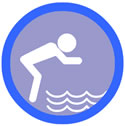 Though swimming pool accidents are sometimes the result of reckless participant behavior, they can also be caused by inadequate supervision, warnings, structures, or defective pool design. Structures commonly found in or near swimming pools include slides, ladders, diving surfaces and fencing. Pools must also be equipped with appropriate markings, signage and warnings indicating pool depths and other potential hazards. In addition, the safety of a pool's design and surrounding walkways, which may become too slippery when wet, must be considered. For this reason, many municipalities publish ordinances and associations provide detailed information regarding pool safety.
Though swimming pool accidents are sometimes the result of reckless participant behavior, they can also be caused by inadequate supervision, warnings, structures, or defective pool design. Structures commonly found in or near swimming pools include slides, ladders, diving surfaces and fencing. Pools must also be equipped with appropriate markings, signage and warnings indicating pool depths and other potential hazards. In addition, the safety of a pool's design and surrounding walkways, which may become too slippery when wet, must be considered. For this reason, many municipalities publish ordinances and associations provide detailed information regarding pool safety.
Expertise
We have extensive experience in many aspects of swimming pools including:
- Swimming pool depth surveys
- Building codes & standards
- Safety lines for separating deep from shallow areas
- Signs, appropriate pool markings and warnings (e.g. No Diving)
Questions Answered
Through scientific analysis, we can help you answer pertinent questions such as:
- Does the pool comply with local building code requirements?
- Are the warning signs adequate?
- Is the pool surrounding surface slip resistant?
- How was the diver's neck injured?
Case Examples
Drowning in Public Pool:
A young child entered the shallow side of a swimming pool and began walking toward the deep side. At a certain point along the way, he lost his footing and eventually drowned. Our investigation revealed that the safety line, a rope attached to floats that separates the shallow and deep areas, was absent. In addition, the slope of the pool bottom was too steep, in violation of standards. These two factors, which we cited, contributed to a rapid settlement.
Slip & Fall in a Swimming Pool:
A man walking toward the swimming pool in his housing development slipped several feet from the pool's edge and was severely injured. We discovered that a four foot wide strip of the concrete surface surrounding the pool had been painted. As a result, the surface could not absorb water, causing puddles, which resulted in a significantly reduced coefficient of friction. After we showed that this slippery condition was the cause of the accident, the case settled.
Kristopher J. Seluga, PE, is a Mechanical Engineering, Accident Reconstruction, Biomechanics, and Safety Expert with over 20 years of experience. He received his Bachelor's and Master's degrees from the Mechanical Engineering department at MIT where he worked on the development of novel three-dimensional printing technologies. Mr. Seluga is also a licensed Professional Engineer in New York and Connecticut, and has served as a member of the ANSI engineering committee for the Z130.1 and Z135 standards for golf cars and PTV's. His research interests and peer reviewed publications span the topics of Motor Vehicle Dynamics, Product Safety, and Biomechanics.
©Copyright - All Rights Reserved
DO NOT REPRODUCE WITHOUT WRITTEN PERMISSION BY AUTHOR.



 Though swimming pool accidents are sometimes the result of reckless participant behavior, they can also be caused by inadequate supervision, warnings, structures, or defective pool design. Structures commonly found in or near swimming pools include slides, ladders, diving surfaces and fencing. Pools must also be equipped with appropriate markings, signage and warnings indicating pool depths and other potential hazards. In addition, the safety of a pool's design and surrounding walkways, which may become too slippery when wet, must be considered. For this reason, many municipalities publish ordinances and associations provide detailed information regarding pool safety.
Though swimming pool accidents are sometimes the result of reckless participant behavior, they can also be caused by inadequate supervision, warnings, structures, or defective pool design. Structures commonly found in or near swimming pools include slides, ladders, diving surfaces and fencing. Pools must also be equipped with appropriate markings, signage and warnings indicating pool depths and other potential hazards. In addition, the safety of a pool's design and surrounding walkways, which may become too slippery when wet, must be considered. For this reason, many municipalities publish ordinances and associations provide detailed information regarding pool safety.






